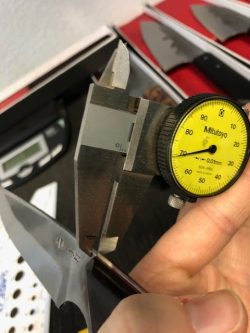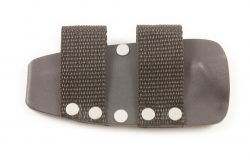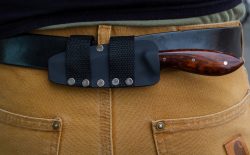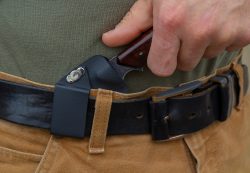All knives stamped with a cursive Carter and three star mitsuboshi are hand-forged, annealed, heat-treated, and hand-sharpened personally by the 17th Generation Yoshimoto Bladesmith and ABS (American Bladesmith Society) Master Smith himself, Murray Carter. Watch him tell his story in this video, Portrait of a Bladesmith.
Muteki knives are forged by graduates of Murray’s rigorous and uncompromising three month Apprentice Program in which the applicants must demonstrate the correct attitude and aptitude for traditional Japanese bladesmithing. The select few who rise to the level of a Muteki bladesmith must be able to consistently produce high-performance blades following strict traditional methods and must embody a deep reverence for the craft.
Read more about our Muteki Bladesmiths here.
The main difference is that Carter knives are forged by Murray Carter, a 17th Generation Yoshimoto Bladesmith and ABS Master Smith with over 30,000 blades forged over a 28 year career (as of 2017), while Muteki knives are forged by Murray’s qualified journeymen bladesmiths under Murray’s supervision.
Carter knives are precision forged to within 95% of their final shape, heat treated in a pine charcoal fire, and have all the metallurgical work done personally by Murray. Carter knives include premium handles with contrasting liners, mosaic center pins, and the famous scary-sharp “Carter” edge that Murray does by hand. Carter knives exhibit artistic handle design utilizing premium synthetics and exotic woods ranging from G10, carbon fiber, Micarta, and natural stabilized woods.
Muteki knives are forged to within 80% of their final shape. They are heat treated in a coke fire. The work is done by Muteki journeymen smiths under Murray’s close supervision. They include hand-sanded handles made of traditional materials and riveted pins. In simpler terms, the Muteki series offers the incredible cutting performance Carter Cutlery is known for at a competitive price point.
Whether it’s our knives or the products we carry, we represent only the finest specimens of any genre of products, and refuse to carry “bargain” brands or anything that would compromise Carter Cutlery’s reputation of excellence.
- Nano Hone System: Nano Hone offers a complete range of sharpening products to fulfill your sharpening needs. These are Murray’s hand sharpening instruments of choice due to its simplicity and harmony of the system.
Hand-forged knives have the potential to exhibit better metallurgy than their non-forged counterparts. Specifically by better metallurgy, we mean the steel has a more refined and consistent grain structure throughout the blade which will result in sharper, longer lasting edges that are easier to sharpen. The way to achieve optimal grain structure in Hitachi blade steel is to hammer it hundreds of times at progressively lower forging temperatures under the careful attention of an experienced bladesmith.
Watch this video for an in depth look at Murray’s thoughts on metallurgy.
When Murray refers to traditional Japanese bladesmithing, he is specifically talking about the centuries old process of heating simple, high carbon steels in a solid fuel forge and laminating that to softer iron at the lowest possible temperatures in a process known as forge welding, and then hammering the steel with the intention of purifying and refining it. That is followed by a unique annealing process wherein the heated blade is inserted into rice straw ashes to cool slowly. To increase the overall performance, the blade is hammered cold before quenching, a process known as cold forging. The blade is then coated in a unique clay slurry, heated again in a solid fuel forge, and then quenched in lukewarm water. Blades that survive the extreme quenching process are then arduously ground on slow rotating water stones to optimum edge geometry and then hand honed to a true razor’s edge.
All of our knives are made with laminated steel. In traditional Japanese fashion, we use sanmai (three layer) construction and kataha (two layer) construction. Murray has worked exclusively with Hitachi White Steel as the core of his knives in the past, but he now works with both Hitachi White and Blue steels, the cleanest cutlery steel in the world when it comes to contaminates such as sulfur and phosphorous. The outer laminates can range from SUS410 stainless steel, mild steel (gokunantetsu), 1035 high tensile steel, or Damascus layering.
Watch this video for more information on what steel Murray prefers.
Damascus is the result of forge welding steel of varying qualities together into one billet. It often requires cutting, restacking, and repeated forge welding to achieve the desired final layer count. The process can take many hours and in some cases days to complete. Damascus offers Murray a chance to incorporate more skill and expertise into the metal, compared to forging non-Damascus steel into a knife. This is due to an increase in the number of heating and forging operations. It can be compared to the customization of a commercially available product such as a car. The more the car is modified, i.e. customized, the more the work will resemble the skills, spirit and personality of the artisan doing the work to it. In this way, Damascus allows Murray to make a unique end product, and gives him the chance to put more of himself into the steel. Likewise, whether Damascus cuts well or not, it reflects the ability and spirit of the smith much more than the inherent qualities of Damascus itself. Here is a video of Murray forging Damascus billets.
Carter Cutlery utilizes both in house hand forged Damascus steel as well as proprietary Damascus which is custom made for us in Japan.
Murray’s Damascus blades benefit from the same sharpening and maintenance regiments of our non-Damascus knives. In this video, Murray talks about the maintenance of Damascus knives.
Neck knives may have a forge finish or a hammer finish and be polished or unpolished. The difference is aesthetic and you can expect the same excellent performance from all of them.
Carter Cutlery offers multiple series of kitchen knives: Kurouchi, Stainless Fukugozai, High Grade, and International Pro. Each series is unique with their own characteristics, qualities, and benefits.
Kurouchi: Traditional rural Japanese cutlery with a ground and polished edge and a black forged patina on the unsharpened portion of the blade.
Stainless Fukugozai: Typically finished with a ground and polished edge and a polished unsharpened portion of the blade showing evidence of the forging process.
High Grade: The steel is polished to an easily maintained finish.
International Pro: These blades can be finished in any one of the above methods.
Damascus: Typically ground and polished, etched with acid, and then polished again to emphasize their unique layered texture.
Muteki: Most blades have a ground and polished edge with a lightly polished unsharpened portion showing remnants of the forging process.
Our sheaths are made from kydex and come in a variety of styles. Each sheath is custom molded to that specific knife. The vast majority of our neck/utility/outdoor knives already comes with a sheath included in the price. The fee for the sheaths are only calculated when purchasing additional sheaths.
- Most of our neck knives come with a neck sheath designed to be worn around the neck with a paracord lanyard. Additional neck sheaths are $35.
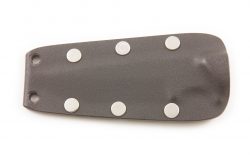
- Most of our larger outdoor knives comes with a tactical sheath which features additional holes to allow threading of the paracord in ways to accommodate belt carry, among other versatile configurations. Additional tactical sheaths are $40.

- A horizontal belt sheath is $45 and comes with a choice of 3 different sized nylon loops (1.25”, 1.5”, 1.75”).
- An inside-the-waistband (IWB) belt sheath is $45 and has a kydex clip that goes around the belt, while the entire sheath is designed to sit inside the waistband.
- We offer kydex sheaths with an UltiClip attachment for $55, ideal for pocket carry.


- Our Carter FS1 knives comes with a tactical sheath with a Tek-Lok system — we can make these sheaths for other knives for $60.
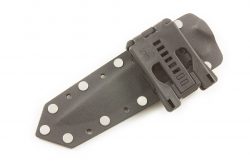

In most cases, we can make sheaths for knives from other makers. Please contact us directly for more information.
Sun = An old unit of measurement in Japan, similar to our inch, but divided into ten “bu.” Ten sun = one shaku, about a foot. 1 sun ≈ 1.193 in
Hocho = “Kitchen knife.” Also seen as “bocho.” Literally in Japanese it means “kitchen worker,” which is indeed what these knives are.
Fukugozai = “Composite material.” At Carter Cutlery, this refers to a core of white steel with SUS410 stainless steel on the outside.
Kurouchi = “Black hammered.” A knife that has the upper half of the blade unpolished. Very characteristic of traditional Japanese knives.
Wabocho = “Japanese kitchen knife.”
Santoku = “Three virtues.” A multi-purpose knife that can be used for both push- and draw-cutting of meat, vegetables and fish. Great for chopping and scooping, and easy to sharpen.
Funayuki = “Ship going.” Fishermen used these as they were versatile knives. Great for simple food prep, chopping, and draw-cutting.
Nakiri = “Veggie cutter.” Square end with upturn blade edge makes for push-cutting all kinds of greens with precision. Nakiris posses the unique characteristic of not reducing in length after years of sharpening.
Sujihiki = “Sinew puller.” A long thin slicer for cutting along the sinew to separate large hunks of meat cleanly.
Gyuto = “Beef knife.” Similar to a Western chef knife. Lengthy ones are used for slicing and carving meat, shorter ones for detailed work.
![]()
 Mu teki “without rival.”
Mu teki “without rival.”
![]()
 Mitsuboshi Trademark symbol for “three stars,” registered in the 3rd year of the Keicho Era (1598). Originally shown as 3 circles because to the founding Yoshimoto bladesmiths, stars in the sky looked like little round dots and not the 5 pointed geometric shapes we have come to know in North America. It has been modified in our current logo to reflect the way the stamps usually look in a forged blade when the hardened stamp is hammered into the softer blade at a slight angle, resulting, ironically, in something resembling a moon.
Mitsuboshi Trademark symbol for “three stars,” registered in the 3rd year of the Keicho Era (1598). Originally shown as 3 circles because to the founding Yoshimoto bladesmiths, stars in the sky looked like little round dots and not the 5 pointed geometric shapes we have come to know in North America. It has been modified in our current logo to reflect the way the stamps usually look in a forged blade when the hardened stamp is hammered into the softer blade at a slight angle, resulting, ironically, in something resembling a moon.
![]()
Hon ke “Original Location” or legal owner of a business.
![]()
Indicates a Hitachi White Steel #1 core. No longer in use.
![]()
Indicates a Hitachi Blue Super Steel core.
![]() Indicates a forge welded blade in my own shop Honwarikomi or Honkasumi. No longer in use.
Indicates a forge welded blade in my own shop Honwarikomi or Honkasumi. No longer in use.
 Muteki Symbol
Muteki Symbol
 Forged by Jamison Chopp
Forged by Jamison Chopp
 Forged by Alex Horn
Forged by Alex Horn
 Forged by Taylor Shields
Forged by Taylor Shields
 Forged by Ryan Cavallo
Forged by Ryan Cavallo
 Forged by Chloe Kim
Forged by Chloe Kim
 Forged by Timothy Stokes
Forged by Timothy Stokes
 Forged by Gavin Aarab
Forged by Gavin Aarab
 Te-uchi, hand forged
Te-uchi, hand forged
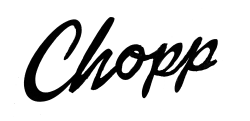 Jamison Chopp muteki signature series
Jamison Chopp muteki signature series
 Alex Horn muteki signature series
Alex Horn muteki signature series
 Muteki Zen series
Muteki Zen series
Our knives should be hand washed and dried thoroughly. The best performance is achieved through a regular sharpening and maintenance regiment. When not in use, our blades should be stored in their original boxes or cases. The fine edges will last the longest if you avoid contact with other hard objects such as ceramic plates, other metallic objects, kitchen cutlery, etc. For more information, pick up a copy of Blade Sharpening Fundamentals.
Although kurouchi knives do not resist oxidation as well as stainless knives, any discoloration will not affect performance. If you do not like the patina that your knife develops, then it can be removed by sharpening. Kurouchi knives should be treated with the same respect as other high-performance kitchen cutlery — dried after every use and stored safely so it does not bump into anything. If there is going to be a long time between uses then we recommend using non-toxic oil on the knife to prevent rust. Cooking oils are a good choice since they are safe to consume.
There are three possibilities to consider when a blade has chipped or the point has broken off:
- The blade has a coarse grain structure, a result of overheating during the construction of the blade. Blades with fine grain structure typically will be stronger, tougher and offer better edge retention.
- The blade has fine grain structure but has been insufficiently tempered, a process that compromises hardness for toughness.
- The blade has fine grain structure, and sufficient temper, but was pushed past its performance limits with respect to its edge geometry. This can be remedied by removing some thin metal from the blade’s edge by sharpening.
You can learn more by watching the updated video, “Why Blades Chip-UPDATED!!”
What sets our cutlery apart from the industrial standard is the high Rockwell Hardness of the steel core and the extremely thin edge for superb keenness. This combination is ideal for “sharp” cutlery. However, if the blade is forced to do a task for which it was not designed, then it leaves the edge susceptible to “chipping.”
If you chip one of our blades, with our DVD instruction and sharpening stone set, you can learn to repair it yourself, but you may also return the blade to us and we will repair it for a small fee. Sharpening does not affect the performance of the blade and is a regular form of maintenance for Japanese style cutlery.
We recommend the use of water stones to sharpen all cutlery (especially ours). Sharpening your knife is an essential part of owning high-performance cutlery and will truly make the knife “yours.” In theory, sharpening is quite simple. However, in practice, it requires patience and experience to become proficient. For those that would like to learn freehand sharpening, we hope you will consider our award-winning Sharpening Instruction Videos. You can also sign up for our Free Knife Care and Maintenance Tips in which we cover the 7-step knife sharpening procedure and give you one free knife sharpening.
The most direct way is to purchase our Knife Sharpening Service before sending your knives to the following address:
- Carter Cutlery
- 103A Moser Ave
- Council, ID 83612
Please include a note with your contact information, return shipping address and any special instructions. Be sure to package your knife in a sturdy box with something protecting the tip and edge of the knife. You may include payment with the knife – the fee is $30 for one knife plus $15 for shipping, and $25 for each additional knife. Alternatively, let us know ahead of time that you are sending us your knife for sharpening and we can contact you after the work is complete for payment information.
Our knives can sell out very quickly. Each knife is unique so when you see one that is right for you, grab it before it’s gone! The best way to keep up with new products is to subscribe to our New Product Alerts, which will automatically send a summary of the knives that are listed to you via email.
At this time Carter Cutlery is not taking custom orders. Murray has realized that in the time it takes to complete one custom order, he would be able to produce multiple knives of superior quality and use his expertise to choose the best dimensions and materials of the final product at his discretion.
In the past, custom orders have taken more than a year to complete. Eliminating custom orders enables Carter Cutlery to stock a more diverse selection of knife styles and ultimately benefits our customers as we can offer this larger selection without the pause in production for a custom order. We will continue to produce a wide variety of knife styles paired with specially selected handle materials.
If you are looking for a particular product and do not see it in our selection, we suggest signing up for our New Product Alerts which will automatically send a summary of the knives that went on sale that day to your email. Additionally, we do appreciate feedback and product inquiries as we will gladly discuss requests at our weekly meetings to see if any of the makers might be inspired to create something close to what you are looking for.
Our preferred method of shipping is USPS Priority Mail. We have a 99.9% success rate when shipping with USPS and find them to be consistent and quick. A tracking number is automatically sent to your email as soon as your order is shipped. If you are in the United States, then USPS Priority Mail takes an average of 2-3 days. For international customers, shipping time varies depending on customs. We can accommodate some requests for other shipping providers, such as FedEx or UPS, but please be aware that it can add an extra day and additional cost before the order is shipped. Contact us directly with any specific shipping requests.
Murray Carter’s Traditional Japanese Bladesmithing School is the only one of its kind in the world where Murray shares traditional Japanese bladesmithing and production techniques that he has learned over his 28 year career that has made Carter Cutlery a successful business. There are classes geared to students of all skill levels. Click here to find out more about the courses.
People are always welcome to visit our storefront. We are open Monday through Friday from 8:30 AM to 5:00 PM. However, we are unable to have visitors inside the forge except by appointment. The best way to see the forge is to visit us during one of our Open House events, which are posted on our Events page and posted on our social media monthly. Please contact us for any other visitation inquires.
Carter Cutlery is always on the lookout for new, gifted talent. However, the physical limitations of our facilities dictates how many apprentices we can teach at any given time, and therefore we select only the most dedicated applicants. Those serious about apprenticing with Carter Cutlery should follow a Four-step application procedure.
First, purchase Murray’s complete Media Package in which he shares all of the essential Japanese bladesmithing tips and techniques. $100 of the cost will be gifted back to the graduates of the Muteki Apprentice program.
Second, submit a one page cover letter with resume and include photographs of anything you have crafted with your hands.
Third, if you aren’t already sharpening knives by hand on Japanese water stones, start right away. Some of the most important lessons in bladesmithing are self-learned by spending hours on the stones. Murray would also like you to send him pictures of what you have sharpened for review.
Fourth, spend some time sketching practical blade designs on paper and submitting them, along with a progress report on hand sharpening to Carter Cutlery via email every 30 days or so after the original application is submitted.
We get many inquiries about appraising or sharpening authentic Japanese Samurai swords and blades. From a purely practical standpoint, Carter Cutlery can straighten, regrind, polish and sharpen one of these blades for a modest fee. However, truly valuable or historic blades should only be serviced by a certified Samurai sword blade polishing expert. A resource for this service in North America is the Nihon Bijutsu Token Hozon Kyokai (NBTHK) in California.
Murray hosts annual tours to Japan for paying clients whereupon he introduces the best names in the industry to his travelers. Outside of this tour, Murray is reluctant to make any recommendations to casual inquirers that he is unable to personally vouch for. The Japanese take personal introductions very seriously and therefore recommendations have to be made with reverence and commensurate respect. We would be delighted to have you join our next guided tour and make these introductions for you in person.
Here is a link for things to do in Japan!
The idea with the blue super and 1035 spring steel is that it is practically indestructible; also, the strength per weight ratio is the strongest we offer.
The white stainless gives you a keener edge and sharpens easier; the stainless steel makes it easy to maintain, but typically, we leave them heavier to compensate for the fact that the laminate is not as tough as the blue super 1035 combination.
Carter Cutlery company policies can be accessed on the website under Policies at the bottom of every page. Information such as our Shipping/Return policies, Payment Policies, Privacy Policy, and our Terms of Use are available there. If you cannot find the information you’re looking for, please contact us.
Our Muteki Zen series is an avenue for the Muteki smiths to make knives outside of our standard laminated construction. The Zen knives feature homogenous high carbon steel blades, using a potential variety of steels such as 52100, 1095, or SK-5. These knives are all forged using a coke fire, with the primary focus being superior metallurgy and cutting performance. However, some steels may undergo different heat treating methods than white or blue steel; for example, oil quenching or oven tempering. These knives may also feature differential hardening, hamons, or integral bolsters depending on the desires and experience of the smith. Because these knives may undergo different processes than the traditional methods taught by Murray for laminated blades, we created the Zen line. Muteki Zen knives can be identified by the “ZEN” stamped next to the muteki mark on knives.
Murray has not always stamped his blades consistently. As each blade is created from the heart, the completed blade and handle itself is considered more of a “maker’s mark” then the stamps themselves are. While an effort has been made to include the “Mitsuboshi” mark recently, older blades may not have them. What truly matters is the presence of the “Carter” stamp, which assures Murray’s best effort went into forging the blade.
In order to maximize the full potential of Japanese laminated steel, it has to be forged in an exact way with extreme temperature control, carefully annealed in rice straw ashes, cold forged, coated in special clay and then quenched in water. Once a bladesmith can demonstrate to Murray fundamental understanding of how to work the steel for maximum results, he will authorize them to purchase it from Carter Cutlery. This is in order to prevent substandard blades being made which could tarnish the fine reputation of our proprietary laminated steel.
The Carter Elbow is Murray’s unique contribution to the cutlery industry. He combined the best features of a traditional Japanese Wabocho kitchen knife with his Wharncliffe Brute neck knife. This design feature allows more steel to reinforce the forward tip of the blade compared to Gyuto or French style chef knife profiles.



The Carter Safety Heel is a small feature to help prevent the knife user from cutting themselves on the very heel when choking up on the knife handle in use. Repeated sharpening will eventually remove the safety heel, which can be added again with judicious grinding, or sending it back in to Carter Cutlery.
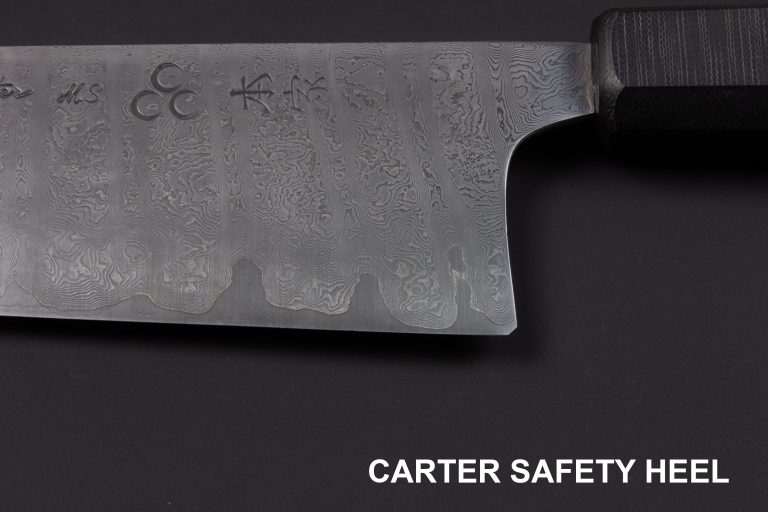
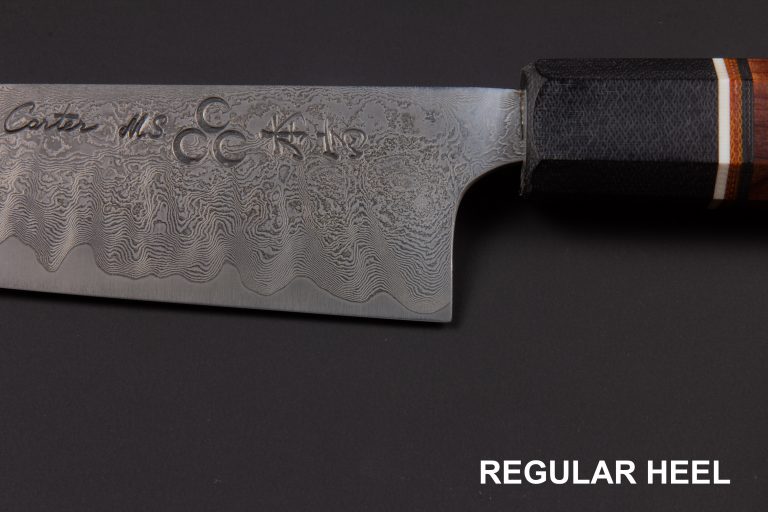
Because all of Carter Cutlery blades have a forged distal taper (thicker in the middle, more thin towards the tip), the blade thickness given is dependent on what part of the blade is measured.
On kitchen knives, we measure the blade thickness at the stamp.

On neck knives and outdoor knives, we measure just in front of the handle.
